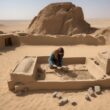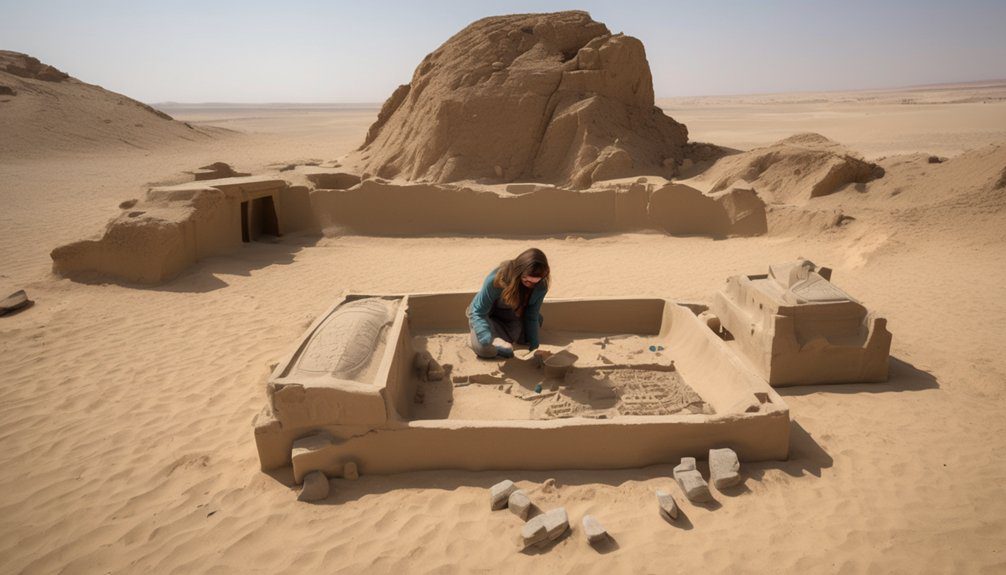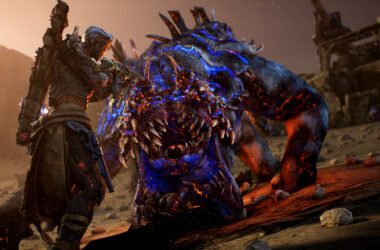You’ll find that Kathleen Martinez’s investigations at Taposiris Magna use a blend of ancient texts and modern technology like ground-penetrating radar. She uncovered tunnels, carved reliefs, and artifacts such as coins bearing Cleopatra’s image, all pointing to a significant Ptolemaic burial site. While definitive proof of Cleopatra’s tomb remains elusive, the evidence strongly supports this location. Exploring further reveals how these findings reshape our understanding of Cleopatra’s final resting place and her era.
The Historical Context of Cleopatra’s Burial
Although the exact location of Cleopatra’s tomb remains uncertain, understanding the historical context of her burial helps frame the search.
You need to take into account that Cleopatra ruled during a turbulent era marked by Roman expansion. After her death in 30 BCE, it’s believed she was buried alongside Mark Antony, her ally and lover.
The burial likely took place in Alexandria, Egypt, a city central to her reign. Political shifts and subsequent city developments may have obscured the tomb’s location.
Knowing these details helps you appreciate why finding the burial site is challenging but essential to understanding her legacy.
Kathleen Martinez’s Archaeological Approach
Since traditional methods have yet to reveal Cleopatra’s tomb, Kathleen Martinez has adopted a unique archaeological approach that combines historical research with modern technology.
You’ll find she carefully studies ancient texts and maps to guide her investigations, ensuring a strong historical foundation. She then uses ground-penetrating radar and other non-invasive technologies to explore promising sites without disturbing the area prematurely.
This method respects the site’s integrity while maximizing data collection. By integrating past knowledge with current tools, Martinez offers a balanced, systematic way to pursue Cleopatra’s elusive burial place, providing you with a methodical path toward discovery.
Key Discoveries at Taposiris Magna
Excavations at Taposiris Magna have revealed several significant findings that shed light on the search for Cleopatra’s tomb.
You’ll find that the site offers a unique glimpse into Ptolemaic history through:
- Intricately carved stone reliefs depicting Egyptian and Hellenistic symbols.
- Subterranean tunnels and chambers that suggest ritual or burial purposes.
- Artifacts such as coins and inscriptions referencing the Ptolemaic dynasty.
These discoveries provide a foundation for understanding the site’s importance while keeping the focus on its archaeological potential.
Evidence Supporting the Tomb Hypothesis
The findings at Taposiris Magna have paved the way for analyzing specific evidence that supports the theory of Cleopatra’s tomb being located there.
You’ll find artifacts like coins bearing Cleopatra’s image, which suggest a connection to her reign. Additionally, the discovery of burial shafts and chambers aligns with the practices of elite Egyptian burials.
Inscriptions referencing Ptolemaic rulers also strengthen the case. While definitive proof remains elusive, the combination of these elements provides a compelling argument.
This evidence encourages you to contemplate Taposiris Magna a serious candidate for Cleopatra’s final resting place.
Implications for Egyptology and Future Research
While definitive confirmation of Cleopatra’s tomb remains pending, the ongoing discoveries at Taposiris Magna have significant implications for Egyptology and future archaeological research.
You can expect new insights into Hellenistic Egypt’s cultural dynamics and burial practices.
This work encourages:
- Using advanced technology to explore undiscovered sites
- Rethinking historical narratives about Cleopatra and her era
- Collaborating internationally to share findings and expertise
These developments open doors for fresh interpretations and methodologies.
If you follow this research, you’ll witness how it challenges established views and inspires freedom to explore Egypt’s rich past with innovative approaches.
Frequently Asked Questions
What Inspired Kathleen Martinez to Search for Cleopatra’s Tomb?
You’d be inspired just like Kathleen Martinez was, driven by a fierce passion for uncovering hidden truths and breaking barriers. She couldn’t resist the call to liberate history from mystery and claim Cleopatra’s story for freedom.
How Long Did the Excavation at Taposiris Magna Last?
The excavation at Taposiris Magna lasted about five years. You’ll appreciate how relentless the team was, digging season after season, driven by curiosity and freedom to uncover history’s secrets beneath the sands of Egypt.
Were Any Artifacts Linked Directly to Cleopatra Found?
No, you won’t find any artifacts directly linked to Cleopatra yet. Kathleen Martinez uncovered promising items, but nothing conclusively tied to her. The search continues, keeping hope alive for freedom’s truth to emerge.
What Challenges Did Martinez Face During Her Research?
You faced skepticism from experts, limited funding, and political obstacles while diving into Cleopatra’s mysteries. Despite these, you pushed forward, driven by passion and freedom to uncover history’s hidden truths beneath Egypt’s sands.
Has the Egyptian Government Supported This Archaeological Project?
Yes, the Egyptian government has supported the project, recognizing its cultural importance. You’ll find they’ve provided permits and some resources, showing willingness to uncover history while balancing preservation and tourism interests for the nation’s freedom to explore heritage.






